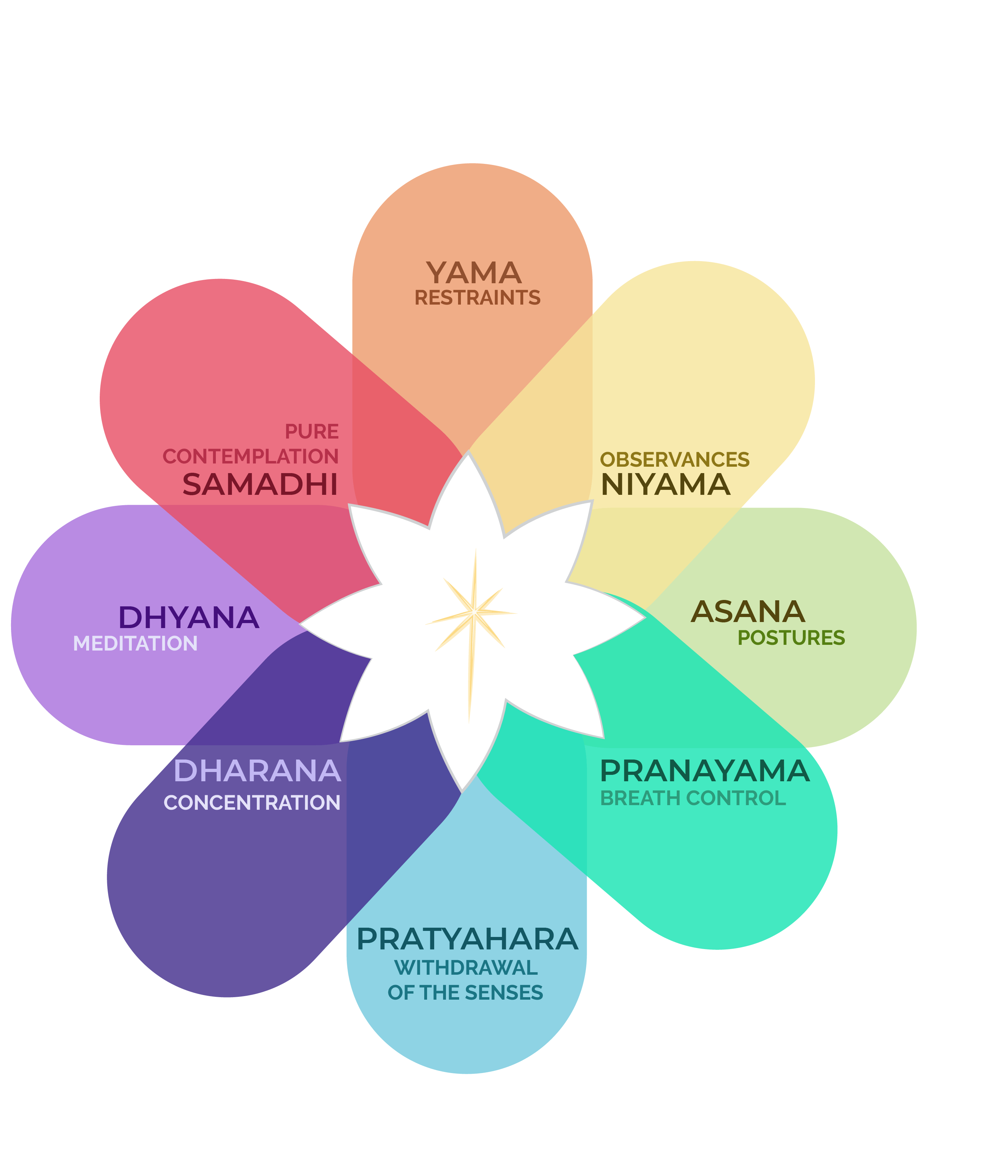Do you need an instant fix of calm, cool and collected? Who doesn’t these days! Lucky for you (and – literally – all of humankind) – there’s a breath practice to help you out.
Yogis have used calming pranayama practices to get out of high gear and into the zen zone for centuries.
Developing a consistent pranayama (yogic breathing) practice can help you access your subtle energy and release blockages that create tension, stress, frenzy in your daily life.
The best part of pranayama, though? You can practice it everywhere you go.
Today, I’ll walk you through three of my all time favorite calming breath practices for getting (and staying) grounded. Say hello to toal mental wellbeing!
How Pranayama Can Keep You Focused, Quiet and Calm
Pranayama is, in fact, the fourth of the eight limbs of yoga. A complete pranayama practice includes a range of different breathing techniques that help us to tune in and direct our prana with skill. In Sanskrit, the word pranayama is translated as “the extension of the vital life force.”
Pranayama techniques vary in difficulty and effect. Some practices are easy enough that children can learn them, while others are reserved specifically for advanced practitioners under the guidance of an expert teacher.
It’s important to remember that when we practice pranayama, we’re not only shifting our breathing patterns; we’re transforming our state of mind.
Think about it: When we feel anxious or over-stimulated, our breath becomes rapid and shallow. If we can intentionally slow, lengthen, and even slightly restrict our breath when our stress response kicks in, we can learn to ease our overexertion.
Manipulating your breath might seem like a counterintuitive way to reduce stress, but it really, really works! There are a number of pranayama practices specifically for relieving stress and anxiety. Any yogi knows from experience what wonders a deep exhale in downward dog can do for our sense of ease, even if it feels a bit forced at first.
Still skeptical? Ask science. To put it simply, the group of nerves in the brain responsible for regulating our breathing have a direct connection to the arousal center of the brain, according to a 2017 paper published in Science magazine. The study shows that breathing directly affects the activity levels in our brains.
Types of Breathing Techniques That Calm The Mind
So what kind of breathing is best for calming down? There are a variety of breathing techniques (both yogic and non-yogic) that effectively calm the mind and have measurable relaxation effects on the body. We talked briefly about how slowing the breath (breath retention) can help to soothe the mind, but there are a few other techniques that have a calming effect as well.
Mindful breathing, for one, is a super simple and intuitive way to calm the mind through the breath. Mindful breathing is one of the most accessible pranayama practices because you don’t really have to do anything – rather, you focus on becoming present with the breath. This is what
To practice mindful breathing, simply close your eyes, and observe the natural pace, depth and rhythm of your breath. Try not to take unnaturally deep breaths immediately – simply be with your breath. Often when we simply bring our awareness to our breath, it naturally begins to deepen, thus soothing our nervous system.
Other soothing pranayama practices include ujjayi breath, nadi shodhana, balanced breathing, and box breathing. If all this sounds unfamiliar to you, don’t worry! We’ll go into detail about them here.
The Energetics of Pranayama
In the proverbial Yoga Sutras, Patanjali describes pranayama as a powerful exercise for moving out of our unconscious form of breathing and into a long, smooth breath. This in turn helps us to create a sense of clarity and ease in our minds. This clarity comes from listening deeply into the subtle body.
Anytime we connect with the breath, we connect to our subtle body. The subtle body consists of our energetic and intuitive experience of reality. In the subtle body, there are thousands of nadis, or energetic channels, through which our prana flows. Our subtle body houses the seven chakras and Kundalini energy, and through it, we experience the energy of the divine.
Practicing pranayama strengthens our connection to the subtle body and integrates our mental, emotional and physical experience into a continuous flow of being.
Telltale Signs That You Can Benefit from Calming Pranayama
There is zero shame in needing a timeout. Life is stressful. There’s really no way to avoid it. What we can do, though, is to change our reactions to difficult situations. If you feel easily overwhelmed, anxious, or frazzled, these may be signs that you need to strengthen your prana and your connection to the subtle body. If you’re like, No, Brett, I just don’t have time for this – then hello, YES that is also a red flag that you need to make time right now to calm down with pranayama.
Because here’s the thing: As you strengthen your pranayama practice, you strengthen your ability to prioritize. And with a bit of patience, you will naturally find clarity, focus and calm in your life.
While everyone can benefit from a pranayama practice, there are some common tell-tale signs that you need to get on it. If you regularly experience any of the symptoms below, take about 20 minutes to breathe with me in one of the tutorials below:
- You feel easily overwhelmed and agitated when things go wrong
- You have trouble falling or staying asleep
- You suffer from chronic pain
- You find it difficult to focus your attention for long periods of time
- You are impatient in social interactions and overly focused on getting to the next to-do list item in your day
3 Calming Yogic Breathing Exercises
1. Sitali Pranayama (aka Taco Breathing)
Sitali pranayama was always intriguing to me, because I instantly noticed the effects it had on my body after I first tried it. Sitali is often called the “cooling breath.” By allowing your breath to intentionally flow while you curl your tongue, you create a cooling effect for the mind and body.
In the Hatha Yoga Pradipika, Sitali is suggested for the hotter summer months or for those with a Pitta imbalance in Ayurvedic medicine. Physically, you could benefit from Sitali when you feel hot flashes or need to send coolness into the body after an active yoga practice. Mentally, Sitali can help to reduce anger, calm the mind, and aid in focus.
Practice It With: Sitali is a wonderful practice to use right after a really active, heat-producing vinyasa class. The cooling energy of the breath will help balance out the heat created in your body. Sitali will also be helpful if you’re feeling a bit “hot headed”.
2. Ujjayi Breath
Also known as ocean breath, ujjayi pranayama is one of my absolute favorite yogic breathing techniques. It’s widely taught in vinyasa and ashtanga yoga because it regulates the inflow and outflow of breath and enables smooth movement transitions. I’ll sometimes use ujjayi if I’m feeling cold, or if my body feels stagnant and stiff. I recommend ujjayi as a calming practice because the oceanic sound of the air helps to tune out of the noise around you and into your inner space at any given point of time. Experienced yogis often drop right into ujjayi whenever they practice, finding that it instantly clears the sacred headspace in preparation for deep work.
Practice It With: Ujjayi breath pairs really well with movement-based practices (like this twisting flow from my Kali challenge). The most common use is during a vinyasa or ashtanga practice. But you could also use ujjayi during ecstatic dance, Tai Chi, or any other way you love to connect with your body.
3. Alternate Nostril Breathing
Alternate nostril breathing, or nadi shodhana, is my go-to calming breath for moments when I need balance drive with a good dose of chill. Nadi shodhana balances the dual energies of yin and yang in the body. It’s a bit more involved than the other breaths mentioned above, with hand gestures and breathing in and out of certain nostrils, but I find the coordination involved actually focuses a frazzled mind and is super soothing.
Practice It With: Since alternate nostril breathing is all about bringing the body into equilibrium, I love pairing this practice with practices like stream of consciousness journaling. Try to journal out three pages of whatever is on your mind, then practice alternate nostril breathing and center mental balance.
Tips for Taking Your Calming Breath Practice On-The-Go
Let me say from experience that calming breath practice is most helpful when we’re out and about, without access to our mat and a quiet meditation space. But one of the incredible benefits of pranayama is that you can take it on-the-go with you! You might not think of it at the moment, but if you notice yourself contracting with tension, or feeling anxious or angry, that’s probably when you need your practice the most.
It’s a lifelong practice to detach ourselves from the compulsive hooks of the outside world. So if you’re struggling to remember your mindfulness practices in moments of anger or anxiety, that’s ok. Start one day at a time. Here are some tips for taking your calming breath practice on-the-go with you in your life.
- Ground down where you are. If you’re out and about, take a moment to place both feet evenly into the ground and relax your shoulders as you exhale. Feel the Earth below you as a supportive mass.
- Use counted retentions to skillfully respond. If you feel yourself about to say something out of anger or hurt, take a moment to close your eyes. Take one deep breath, counting to five on the inhale and five on the exhale. Then, honor your emotions with a skillful response.
- Pause and breathe mindfully. When you find pockets of space in your daily life (like waiting in line or driving) try to practice mindful breathing. Notice the depth and length of your breath. Notice how your awareness changes your breath.
- Exhale the excess. When you feel moments of excess energy or intensity, try to take a few exhales through an open mouth. This helps to release excess energy and bring your body back towards balance.
- Practice diaphragm breathing. Oftentimes, we’re breathing too shallow and up in our chest. Try to start your inhales all the way down at the base of your belly and fill all the way up with air. By using the full capacity of our lungs like this, we provide vital oxygen and energy to our bodies.
Experience 3 Training Videos from Inside My 200-Hour Online YTT

YOU MIGHT ALSO LIKE
- What is Yoga Alliance and Do I Need an RYT Certificate to Teach Yoga?
- 200 Hour Yoga Teacher Training: What To Expect, How To Prepare, Where To Do It
- Is An Online Yoga Teacher Training Worth The Investment?
- Levels of Yoga Certification: What’s The Difference Between 200-, 300-, and 500-Hour YTT Courses?yoga certification
- What Does A 500 HR Yoga Teacher Training Course Cover? Standards and Benefits
- A Guide to The Best Yin Yoga Teacher Training Programs
- Hatha Yoga Teacher Training Certification: Immersion, Online, or in Studio?
- Wanna Teach Kids Yoga? Find A Fun Childrens Yoga Teacher Training!
- Ashtanga Yoga Teacher Certification: Where And How To Get It
- How To Know If An Online YTT Is Legit: 8 Things To Look For
- Want to Become a Certified Vinyasa Yoga Teacher? Read This.
- How to Choose a Yoga Teacher Training (That Won’t Rip You Off)
Learn how to do 11 of the most popular yoga poses correctly. Free video + PDF download.












